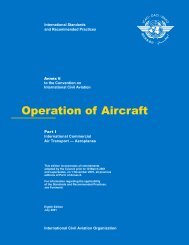Aircraft Operations
Doc 8168 Aircraft Operations, Volume I Flight Procedures
Doc 8168 Aircraft Operations, Volume I Flight Procedures
- No tags were found...
Create successful ePaper yourself
Turn your PDF publications into a flip-book with our unique Google optimized e-Paper software.
Part II — Section 3, Chapter 1<br />
II-3-1-9<br />
1.7.3 Stepdown fixes<br />
1.7.3.1 A stepdown fix is flown in the same manner as a ground-based approach. Any required stepdown fixes<br />
prior to the missed approach waypoint will be identified by along-track distances.<br />
1.7.3.2 Where the FMC includes a vertical navigation capability, the navigation database procedure may contain a<br />
continuous descent flight path that remains above the stepdown procedure vertical profile. Use of FMC vertical<br />
navigation capability will be subject to flight crew familiarity, training and any other requirements of the operational<br />
approval.<br />
1.7.4 Descent gradient/angle<br />
The optimum descent gradient/angle is 5.2 per cent/3°, however where a higher gradient/angle is necessary, the<br />
maximum permissible is 6.5 per cent/3.7°. The descent gradient/angle is published.<br />
1.8 MISSED APPROACH SEGMENT<br />
1.8.1 CDI sensitivity<br />
1.8.1.1 For basic GNSS receivers, sequencing of the guidance past the MAPt activates transition of the CDI<br />
sensitivity and RAIM alert limit to terminal mode (1.9 km (1.0 NM)).<br />
1.8.1.2 While these criteria may apply, some FMCs may incorporate different display sensitivities for missed<br />
approach operations. These different display sensitivities may be used when there is guidance provided by flight<br />
director cues or autopilot. Regardless of the missed approach display sensitivity differences with the FMC GNSS<br />
implementations, equivalent integrity of the operation must still be provided.<br />
1.8.2 A GNSS missed approach requires pilot action to sequence the basic GNSS receiver past the MAPt to the<br />
missed approach portion of the procedure. The pilot must be thoroughly familiar with the activation procedure for the<br />
particular basic GNSS avionics implementations installed in the aircraft and must initiate appropriate action after the<br />
MAPt.<br />
1.8.3 Activating the missed approach prior to the MAPt will cause CDI sensitivity to immediately change to<br />
terminal (±1.0 NM sensitivity), and navigation guidance will continue to the MAPt. The guidance will not be provided<br />
beyond MAPt or initiate a missed approach turn without pilot action.<br />
1.8.4 If the missed approach is not activated, the basic GNSS avionics implementation will display an extension<br />
of the inbound final course and the along-track distance will increase from the MAPt until it is manually sequenced<br />
after crossing the MAPt.<br />
1.8.5 These criteria generally apply to FMCs. There will, however, also be installations, especially those using<br />
navigation information on the moving map display, where the FMC path guidance will be continuously displayed for<br />
the missed approach.<br />
1.8.6 For the basic GNSS receiver, missed approach routings in which the first track is via a specified course<br />
rather than “direct to” the next waypoint requires additional action by the pilot to set the course. Being familiar with all<br />
of the inputs required is especially critical during this phase of flight.<br />
1.8.7 The missed approach tracks are typically included in the FMC’s navigation database, such that no pilot<br />
action is required.<br />
23/11/06












